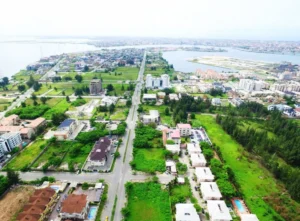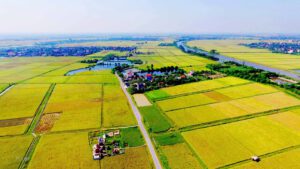Agricultural land use tax
-
Does agricultural land have to pay tax?
Agricultural land used for agricultural production must be taxed by organizations and individuals using such land (also collectively referred to as tax-paying households). In particular, in case of being assigned the right to use agricultural land but not using it, this household still has to pay agricultural land tax.

-
Subjects of agricultural land use tax
Agricultural land use tax payers include:
- Organizations and individuals using land for agricultural production must pay agricultural land use tax, including:
- Farmer households, private households and individuals;
- Organizations and individuals using agricultural land in the land fund reserved for public needs of the commune;
- Agricultural, forestry and aquatic enterprises include farms, forestry farms, enterprises, camps and other enterprises, State agencies, non-business units, armed forces units, social organizations and other units that use land for agricultural, forestry and aquaculture production.
- Households are assigned the right to use agricultural land but do not use it.
Accordingly, the Law on Agricultural Land Use Tax also stipulates that land subject to agricultural land use tax is land used for agricultural production, including:
- Cultivated land;
- Land with water surface for aquaculture;
- Planted forest land.
- Land not subject to agricultural land use tax but subject to other taxes or not subject to tax as prescribed by law, including:
- Land with natural forests;
- Natural grassland soil;
- Land used for living;
- Special-use land.

-
How to calculate agricultural land use tax
Agricultural land use tax = Land area x Tax capitation calculated in kilograms of paddy per unit area of each land grade
In which:
The taxable area of each tax-paying household is the actual land area recorded in the State cadastral book or measurement results.
In case the locality has not yet made cadastral books and the measurement data are inaccurate and have not been certified by the competent land management agency, the taxable area is the land area inscribed in the declaration of the tax-paying household.
In special cases where the land allocation under Decree 64-CP has not yet been carried out in time, the cooperative or production group shall contract to assign to farmer households and individual households the taxable area of each household declared by the household itself and certified by the head of the cooperative or agricultural production group.
The taxable area of each field plot is the actual use area, assigned to each tax-paying household in accordance with the area inscribed in the cadastral book or in the declaration of the head of the household.
Tax capitation calculated in kilograms of rice per unit area of each land class
– For land for planting annual crops and land with water surface for aquaculture:
| Land term | 1 | 2 | 3 | 4 | 5 | 6 |
| Tax Capitation | 550 | 460 | 370 | 280 | 180 | 50 |

– For land for perennial crops:
| Land term | 1 | 2 | 3 | 4 | 5 |
| Tax Capitation | 650 | 550 | 400 | 200 | 80 |
– For perennial fruit trees grown on land planted with annual trees, the tax rate shall be applied:
- Equal to 1.3 times the annual land use tax for planting trees of the same grade, if it belongs to grade 1, 2 and 3 land;
- It is equal to the annual land tax for planting trees of the same grade, if it belongs to grade 4, grade 5 and grade 6 land.
– For land planted with perennial crops harvested once, the tax rate is equal to 4% of the value of the exploited output.
Non-agricultural land use tax
-
What is non-agricultural land?
Non-agricultural land is land that is not used for agricultural purposes, including many different types of land:
– Residential land includes residential land in rural areas and urban areas (also known as residential land);
– Land for construction of agency headquarters;
– Land used for defense and security purposes;

– Land for construction of non-business works, including land for construction of offices of non-business organizations; land for construction of cultural, social, medical, education and training, physical training and sports, science and technology, diplomacy and other non-business establishments;
– Non-agricultural production and business land, including land for industrial parks, industrial clusters and export processing zones; commercial and service land; land for non-agricultural production establishments; land used for mineral activities; land for production of building materials and pottery;
– Land used for public purposes includes traffic land (including airports, airfields, inland waterway ports, maritime ports, railway systems, road systems and other traffic works); irrigation; land with historical-cultural relics and scenic spots; land for community activities, amusement and public entertainment areas; land for energy works; land for post and telecommunications works; market land; land for waste dumping, waste treatment and land for other public works;
– Land for religious and belief establishments;
– Land for cemeteries, cemeteries, funeral homes, crematoriums;
– Land of rivers, rivers, canals, canals, streams and special-use water surfaces;
– Other non-agricultural land, including land for use as rest houses, shacks and camps for laborers in production establishments; land for construction of warehouses and houses for storing agricultural products, pesticides, fertilizers, machinery and tools in service of agricultural production and land for construction of other works of land users not for business purposes but such works are not attached to residential land.
-
Non-agricultural land use tax payers
Subjects subject to non-agricultural land use tax are specified in Article 3 of Circular No. 153/2011/TT-BTC stipulating non-agricultural land use tax payers as follows:
– Taxpayers are organizations, families and individuals with land use rights that are subject to tax.
– Organizations, households and individuals that have not yet been granted certificates of land use rights and ownership of houses and other land-attached assets shall be taxpayers.

– Taxpayers in some specific cases:
- In case of land allocation or land lease by the State for the implementation of an investment project: the person who is allocated or leased land by the State is the taxpayer;
- Persons with land use rights to lease land under contracts: taxpayers are determined according to the agreement in the contract. In case there is no agreement on the taxpayer, the person with the land use right is the taxpayer;
- In case the land has been granted a certificate but there is a dispute, before the dispute is settled, the current land user is the taxpayer;
- If many people have the same right to use a land plot: the taxpayer is the legal representative of the persons who have the same right to use that land plot;
- In case a person with land use rights contributes business capital with land use rights and forms a new legal entity with land use rights subject to non-agricultural land use tax, the legal entity shall be the taxpayer;
- In case the house is owned by the State: the taxpayer is the house lessor; In case of land allocation or lease by the State for the implementation of a project to build houses for sale or lease: the taxpayer is a person who is allocated or leased land by the State.
- In case of transfer of land use rights to other organizations or individuals, the taxpayer shall be the transferee.
-
How to calculate non-agricultural land use tax
According to the provisions of Point 2.1, Clause 2, Article 8 of Circular No. 153/2011/TT-BTC stipulating the formula for calculating non-agricultural land use tax as follows:
Payable tax amount (VND) = Arising tax amount – Tax amount exempted or reduced (if any)

In which:
Tax amount = Taxable land area x Price of 1m2 of land x Tax rate %
– Pursuant to Point a, Clause 1, Article 7 of Circular No. 153/2011/TT-BTC, for residential land (including cases of use for business applied according to the partial progressive tariff), the tax rate will be determined as follows:
| Tax tiers | Taxable area (m2) | Tax Rate (%) |
| 1 | Area within the quota | 0,03 |
| 2 | The area exceeds 3 times the limit | 0,07 |
| 3 | The area exceeds 3 times the limit | 0,15 |
– Other types of soil:
| Tax tiers | Soil Type | Tax Rate (%) |
| 1 | Non-agricultural production and business land and other non-agricultural land used for business purposes | 0,03 |
| 2 | Land used for improper purposes, land not used in accordance with regulations | 0,15% |
| 3 | Encroached land, occupied land | 0,2% |

-
Tax payment time limit
– Time limit for first-time tax payment: Within 30 days from the date of issuance of the tax payment notice. From the second year onwards, taxpayers pay non-agricultural land use tax once in a year no later than October 31.
– The deadline for payment of the difference tax as determined by the taxpayer in the general declaration is March 31 of the calendar year following the tax year.
– The time limit for tax payment for adjusted declaration dossiers is 30 days from the date of issuance of the notice of payment of non-agricultural land use tax.
Above is the content of KALF’s advice on Land Use Tax (agricultural land, non-agricultural land) and related issues. All of our above advice is based on applicable legal regulations. If you have any questions or requests about legal issues, please contact us for timely answers.




